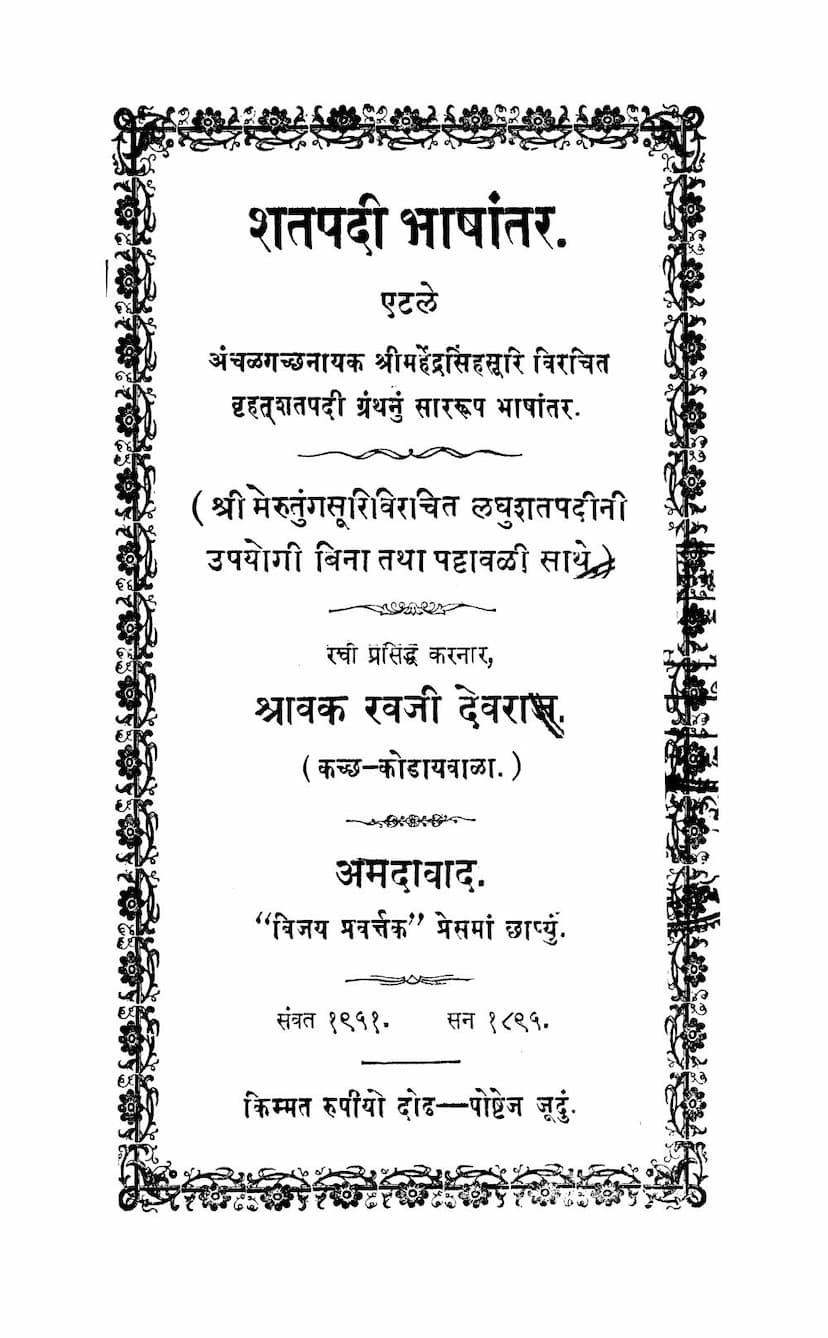Shatpadi Bhashantar
Added to library: September 2, 2025

Summary
This document is the Gujarati translation of the Jain text "Shatpadi Bhashantar" (शतपदी आषांतर) by Mahendrasinhsuri. It was published by Ravji Devraj Shravak and printed in 1895. The title itself indicates that it is a simplified Gujarati translation of the "Vrihat Shatpadi" ( बृहत् शतपदी ) authored by Mahendrasinhsuri, with the added utility and explanations of the "Laghu Shatpadi" ( लघुशतपदी ) by Merutungasuri.
Here's a breakdown of the content and its significance:
Core Purpose: The primary goal of this translation is to make the complex philosophical and practical teachings of the Shatpadi, particularly concerning the conduct and principles of the Anchal Gachha (अंचळगच्छ), accessible to a wider Gujarati-speaking audience. The original Sanskrit text was difficult for many to understand due to its scholarly nature.
Key Components and Themes:
-
Shatpadi Explained: The introduction clarifies that the Anchal Gachha was founded with the principle of adhering to the "Agamavada" (आगमवाद - teachings derived from scriptures). The "Vrihat Shatpadi" by Mahendrasinhsuri, comprising 117 principles, was a Sanskrit adaptation of an earlier Prakrit "Shatpadi" by Dharmaghosh Suri (composed in 1263 Vikram Samvat). The purpose was to provide a clear explanation of Anchal Gachha's practices, which were being forgotten or misunderstood.
-
Addressing the Decline of Pure Practices: The preface highlights a concern that as the knowledge of Sanskrit declined, the pure practices of the Anchal Gachha were being replaced by those contrary to the Agamas, leading to the adoption of practices from other Gachhas. This translation aims to rectify this by re-establishing the ancient and pure practices.
-
Content of the Shatpadi: The book is essentially a compilation of questions and answers, or rather, discussions on specific points of Jain doctrine and practice relevant to the Anchal Gachha. The summarized content, presented in the "Shatpadi nu Saransh" (शतपदीनुं सारांश) sections (pages 7-19, and later detailed in the index), covers a vast array of topics, including:
- Image Worship (Pratima Puja): Discussions on whether images with or without a surrounding (parikar) should be worshipped, the use of clothing adornments on images, whether ascetics (Yatis) should perform consecrations (Pratishtha), prohibition of lamp and fruit/seed worship, allowance of rice grain and leaf worship, specific representations for Parshvanatha and Suparshvanatha, timing of worship, worshipping temples with support (Nishrakrut), and not worshipping at night.
- Layperson's Conduct (Shravak ni Kriya): Emphasis on performing religious duties with a waist-cloth (vastranchal), not establishing "Sthapana Acharyas" (figurative representations of Acharyas), appropriate ways to greet monks, refraining from specific types of false beliefs (Mithyatva), observing the Paushadh (fasting) only on designated days, performing Samayik (meditation) for a fixed duration, the permissibility of laypeople studying scriptures like Avashyak Niyukti, taking repentance (Prayshchitt), and avoiding practices like Upadhan and Malaaropan.
- Festivals and Observances (Parva Babat na Vicharo): Rejection of "Kalyanika" festivals, specific Aso and Chaitra observances, the timing of Samvatsari (annual repentance), the nature of Adhikamas (extra month) and its impact on Paryushana.
- Monastic Conduct (Sadhu na Achar): Guidelines on the staff of monks, forms of worship, specific pronouncements during temple salutations (Thui), the conduct of nuns (minimum number required to travel), use of backrests, living in houses with doors, and the propriety of accepting Modakas (sweets). It also delves into exceptional circumstances (Apavada) where certain strict rules might be relaxed for monks.
- Interactions and General Principles: Discussions on interacting with non-Jains, the permissibility of using writing materials, the rules for greetings, and various practical considerations for monks' daily lives.
-
Laghu Shatpadi: This section (pages 213-224) offers a condensed version of some key points from the Vrihat Shatpadi, focusing on more easily digestible principles. It reiterates many of the points discussed in the main text, such as image worship, prohibited practices, and monastic conduct.
-
Pattavali (Lineage of Acharyas): The book includes a genealogical list of the Acharyas of the Anchal Gachha, tracing its lineage from Mahavir Swami to the current Acharyas, including the publishers and the author. This is crucial for establishing the authority and historical continuity of the Anchal Gachha's teachings.
-
Useful History (Upayogi Itihas): This section provides historical context, including the timeline of significant events, the establishment of various Gachhas, and the lives and contributions of prominent Acharyas like Haribhadra Suri, Abhaydev Suri, Muni Chandra Suri, Dev Suri, and Mahendrasinh Suri himself. It also includes discussions on the origins of the Vadgachha and Anchal Gachha and refutes certain Digambara claims.
-
Digambara Debate: A portion of the text (pages 156-163) engages in a debate with Digambara Jainism, questioning their practices and beliefs, particularly concerning their adherence to nudity versus their use of ritualistic items and their interpretation of certain scriptures.
-
Criticism of Other Practices: The text also critiques certain practices adopted by other Jain sects or modern interpretations, such as the extensive use of "Panchamrita" (five nectars) for worship, the establishment of "Sthapana Acharyas," the reasoning behind certain "Ashthacharanas" (eight improper conducts), and the deviations from established traditions.
Significance:
- Preservation of Anchal Gachha Identity: This book is a testament to the Anchal Gachha's efforts to maintain its distinct identity and practices by grounding them in scriptural authority and providing clear explanations.
- Accessibility of Knowledge: By translating the complex Sanskrit "Vrihat Shatpadi" into accessible Gujarati, the author and publisher aimed to democratize this religious knowledge.
- Historical Record: The book serves as a valuable historical document, detailing the lineage of the Anchal Gachha and the intellectual debates and practices within Jainism during that period.
- Guidance for Lay Disciples: It provides practical guidance for lay Jains on how to conduct their religious lives in accordance with the Anchal Gachha's principles.
In essence, "Shatpadi Bhashantar" is a comprehensive and scholarly work that serves as a cornerstone for understanding the Anchal Gachha's philosophy, history, and ritualistic practices, making this knowledge available to a broader audience through its Gujarati translation.